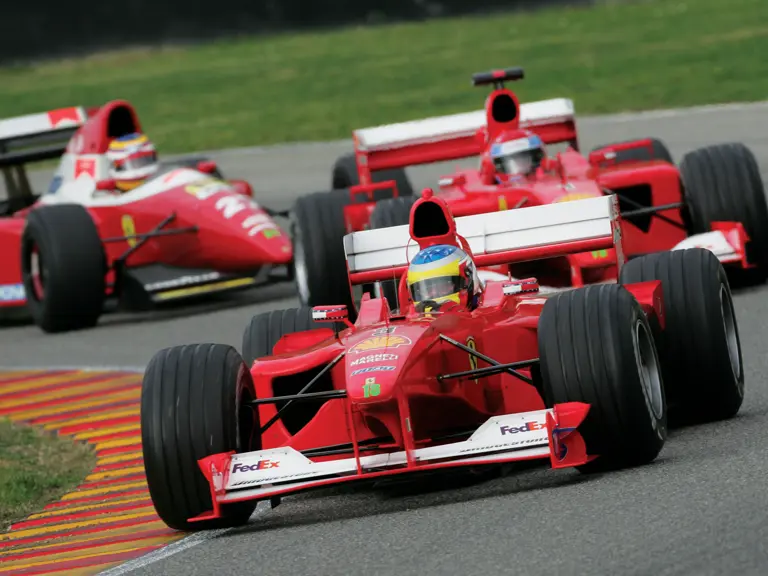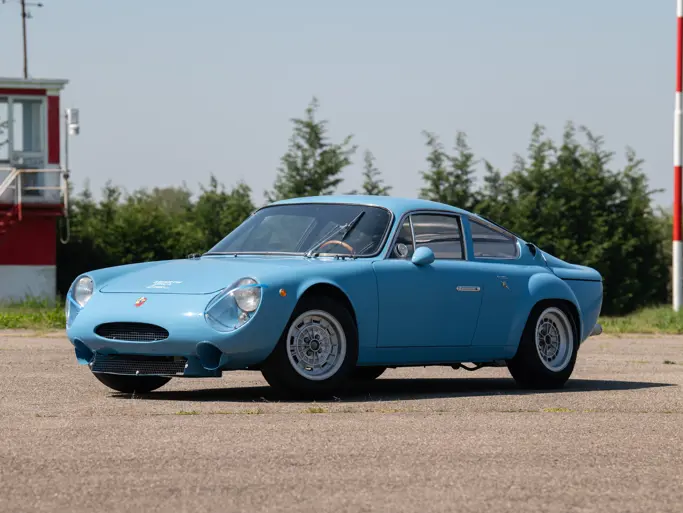
2000 Ferrari F1-2000
{{lr.item.text}}
€806,400 EUR | Sold
{{bidding.lot.reserveStatusFormatted}}
- Raced by Michael Schumacher on his way to the 2000 Driver’s Championship
- Tested extensively by Luca Badoer
- One of only 8 examples built
- First Ferrari designed entirely in the Maranello wind tunnel
- Powerful 820 PS V-10 Engine
- Restored by the Ferrari factory in 2008
- Ferrari Classiche certification
808 bhp, 2,977 cc dual overhead camshaft V-10 engine, seven-speed sequential manual paddle-shift gearbox, independent front and rear double-wishbone suspension, and four-wheel vented Brembo carbon fibre disc brakes. Wheelbase: 3,010 mm (118.5 in.)
The conclusion of the 1999 Formula 1 season saw Ferrari take home the Constructor’s Championship, a feat the manufacturer had not achieved since 1983. Never content with anything but total success, the Scuderia began off-season work on a new car that could further challenge the day’s formidable McLarens and potentially return prodigy driver Michael Schumacher to the Driver’s Championships, which he had enjoyed several years earlier with the Benetton team.
Led by chief designer Rory Byrne, Ferrari’s technical team started from scratch with a mandate for improved aerodynamics, a pursuit that was facilitated by the company’s new wind tunnel in Maranello. The resulting F1-2000 model was the first Ferrari to be conceived entirely in the wind tunnel, a milestone in race car development. Fundamentally revising the weight distribution of the primary components, Byrne and his team significantly lowered the centre of gravity from the prior car, improving aerodynamic efficiency and tyre wear. The suspension was modified with an improved design and new materials, and for the first time, it featured a comprehensive use of carbon composites.
An all-new seven-speed paddle-actuated sequential transmission was mated to a new engine block, a 3-litre V-10 capable of developing 820 PS. Wrapped in a skin-tight shell of carbon fibre and Kevlar-reinforced epoxy, the F1-2000 débuted with a commanding 1-2 finish at the season opening Australian Grand Prix, driven by Mr Schumacher and teammate Rubens Barrichello. By the end of the 2000 season, the F1-2000 had taken the checkered flag 10 times, and in the process, earning Mr Schumacher his 3rd Driver’s Championship and Ferrari a repeat of the Constructor’s Championship. The victories marked the first time in 21 years that Ferrari earned both crowns and paved the way for four more dual championships over the next half a decade.
Chassis number 204 is one of only eight cars produced and has the unusual distinction of being the most minimally raced example. Accruing only 1,128 km over its roughly 18 months of testing, qualifying and racing, 204 was driven on the Fiorano proving track by Luca Badoer in early July 2000, before being assigned to Schumacher for the Austrian Grand Prix on 16 July. Qualifying, respectively, for the 4th and 3rd positions on the starting grid, both Schumacher and Barrichello were immediately trailing the McLarens of Mika Hakkinen and David Coulthard. Before one lap was completed, the charging Hondas of Jarno Trulli and Ricardo Zonta, who started in 5th and 6th, made contact with both Ferraris, resulting in a caution lap and an early retirement for Schumacher and 204.
This car subsequently returned to Fiorano for further testing by Badoer, with Schumacher taking several laps on 9 August, in preparation for the Hungarian Grand Prix of 13 August, where the German driver took 1st overall in chassis 203. After several more months of testing by Badoer, including an accident-causing mechanical failure at the Circuit de Catalunya outside of Barcelona in January 2001, 204 was retired and retained by then-Scuderia manager Jean Todt, who now serves as president of the FIA. On 29 March, 2004, chassis 204 was authenticated by Maranello headquarters with full Ferrari Classiche paperwork.
Purchased by the current owner in 2006, this F1-2000 was restored to peak operating condition in 2008 by the Ferrari factory, a process that cost nearly 150,000 euros, as reflected by receipts that accompany the car’s documentation. This work included outfitting 204 with a new, proper Tipo 049 engine, which has since been driven only approximately 400 kilometres.
With its chiselled athleticism and nearly boundless power, this wonderfully presented and sparingly campaigned F1-2000 is an indelible piece of motorsports history, as it was one of the crucial components of the dual championship 2000 season and enjoyed by the Ferrari Scuderia and Mr Schumacher. Equally worthy of distinguished exhibition as a display piece or the pulse-pounding competition for which it is now ideally prepared, this thrilling F1-2000 is a race-ready example that should capture the hearts of discerning motorsports collectors and Formula 1 enthusiasts everywhere.



 | Monaco, Monaco
| Monaco, Monaco


